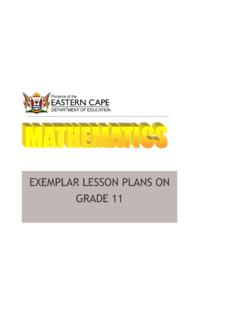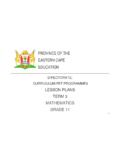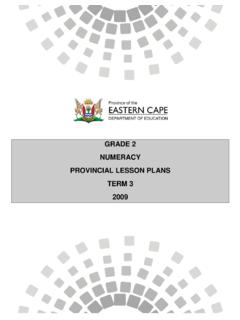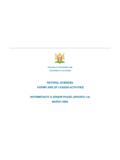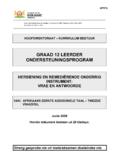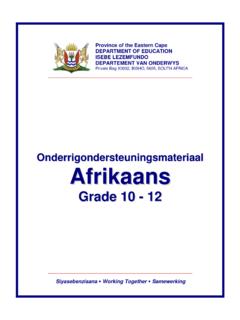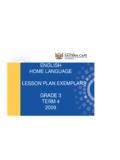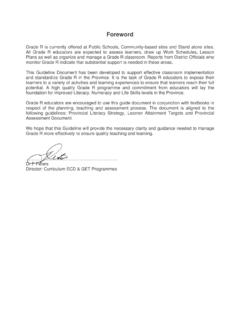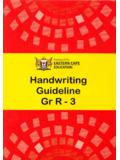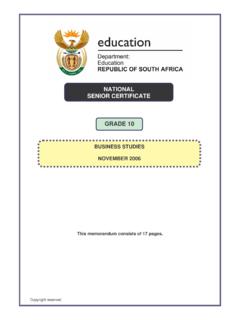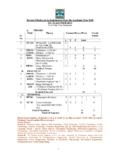Transcription of WORK SCHEDULE: ENGLISH FIRST ADDITIONAL LANGUAGE …
1 WORK schedule : ENGLISH FIRST ADDITIONAL LANGUAGE GRADE 8 TERM 1 Content in Context: Multi Media Texts Integration Across: Resources: TELEVISION PROGRAMMES, WEATHER FORECASTS (excluding Grade 7), ADVERTISEMENTS, FILMS AND VIDEOS, CD-ROMS and INTERNET (where available). Newspapers, Magazines, Poems, Play-scripts, Diaries, Postcards and Letters, Procedural texts ( instructions), Factual descriptions, Reports, Explanations, Textbooks from other Learning Areas, Advertisements, Notices, Posters, Book and Television reviews, Diagrams, Graphs and Charts, Reference books ( encyclopaedias) Messages ( phone messengers); Radio advertisements; Reports of events; Radio talks; Talk Shows Term Learning Outcomes and Assessment Standards Assessment Teaching & Learning Strategies 1,2&3 Multi Media Texts LO 1 Listening AS 2 Understands oral texts ( poems, radio plays): answers questions of growing complexity identifies point of view; retells and summarises.
2 Describes the features or characteristics of different kinds of oral texts ( poem or factual text). Form; Written Products: Creative Writing Tests and examination Class work Composition/ Essay Paragraphs Exhibition and presentation Journal writing Project Written Response to text LANGUAGE Structure Advertisement Book report/ review Round robin Panels Jigsaw Numbered heads together Buzz groups Pairs Brainstorming Hot potato Gallery walk Rainbow groups Role- play Discussions De Bono s six thinking hats Questions and answers Debates Case study LO 2 Speaking AS 2 Interacts in ADDITIONAL LANGUAGE : uses LANGUAGE for a range of functions: offers and invites ( Would you like ..? ), politely refuses ( I m sorry .. ), etc.; takes part in role-plays of different situations involving different kinds of LANGUAGE ( reporting a crime to the police).
3 AS 4 Debates social and ethical issues: shares roles ( chairperson, timekeeper, secretary); brings people into the discussion ( What do you think? , Don t you? ); interrupts politely ( Excuse ); expresses opinions and supports them with reasons ( I d just like to say that .. ); expresses agreement ( You re right. ) and disagreement ( Yes, ); switches languages where necessary. LO 3 Reading & Viewing AS 3 Reads and responds to social texts ( personal letters, notices): identifies purpose, audience and context; describes features of the type of text being read ( a personal letter). Brochure Crossword puzzle Lab report Letter Magazine article Memo Newspaper article Poem Research report Questionnaire Other Oral Products: Role play Oral presentation Vocabulary Listening (Thinking & Reasoning) Reading Debates Demonstration Audio tape Discussion Dramatization Interview Play Poetry reading Rap Song Teach a lesson Other Storytelling Whole class activity Individual activity Group activity Investigation Problem solving activity Games Role play Facilitating Reading Other AS 5 Analyses photographs in texts ( advertisements and newspapers); identifies the subject, context, audience and message of the photo, identifies from whose point of view the photo has been taken; identifies what has been left out of the photo and why.
4 Judges whether the photo is memorable and gives reasons. AS 6 Uses reading strategies: matches different ways of reading to different texts ( scans a telephone directory); develops and evaluates reading speed; uses strategies to work out the meanings of words ( looks at illustrations or diagrams, and discusses the word in home LANGUAGE ). LO 4 Writing AS 2 Writes for social purposes: writes personal letters ( politely refusing an invitation), showing awareness of the text type, of purpose, audience and context, and of register/style; writes e-mail messages. AS 3 Writes for personal reflection: writes a diary AS 5 Designs media texts: designs a simple advertisement or pamphlet Visual products: Advertisement Banner Cartoon Collage Collection Computer graphic Construction Design Diagram Display Drawing Graph Map Model Painting Photograph Poster Sculpture Slide show Story board Video tape Method: Self assessment Peer assessment Teacher assessment Tool: Memorandum Observation sheet/ book Checklist Rubric Journal writes a simple news report AS 7 Uses developing knowledge of LANGUAGE structure and use: makes a text cohesive ( using linking words to link paragraphs); writes good paragraphs with one main idea, a topic sentence and supporting sentences, and is able to reflect on it.
5 Writes introductions and conclusions; adopts a point of view. LO 5 Thinking and Reasoning AS 2 Uses LANGUAGE for thinking: asks and answers more complex questions ( When this is changed, then what else would change? ); writes definitions, classifications and generalisations AS 3 Collects and records information in different ways: selects relevant material and takes notes (organises points under headings; abbreviates words); reads and synthesises information from two simple texts on the same topic; transfers information from one mode to another by, for example, using mind maps. Other LO 6 LANGUAGE Structure and use As 6 Uses modals to express politeness ( Can /Could I borrow a pencil ?) AS 9 Expands vocabulary ( by mind mapping related words, such as words about war). AS 10 Demonstrates an understanding of between 5000 and 7500 common spoken words in context by the end of Grade 8.
6 Learners, who will do someof their learning through their ADDITIONAL LANGUAGE , should aim for 7500 words.. Content in Context: Stories Integration Across: Resources: Stories; Fables; Legends; Descriptions of people and objects; Conversations; Prepared Talks; Books (fiction and non-fiction); Textbooks; Book Reviews; Photographs; Word Puzzles; Reference books; ( dictionaries, encyclopaedias) ; films and videos; CD-ROMS and INTERNET (where available). Term Learning Outcomes and Assessment Standards Assessment Teaching & Learning Strategies 1 & 4 LO 1 Listening AS 1 Understands and appreciates stories, including those told by other learners: Responds personally and critically, asks and answers questions; Evaluates the storytelling technique and performance, and gives feedback.
7 AS 2 Understands oral texts ( poems, radio plays): answers questions of growing complexity; identifies point of view; retells and summarises. AS 4 Listens actively in discussion: Shows openness to ideas and treats the views of others with respect; Invites contributions from others and responds to their views; Is prepared to challenge others but does so politely and does not interrupt them; Criticises the ideas and not the person. Form; Written Products: Creative Writing Tests and examination Class work Composition/ Essay Paragraphs Exhibition and presentation Journal writing Project Written Response to text LANGUAGE Structure Advertisement Book report/ review Brochure Crossword puzzle Lab report Letter Magazine article Memo Round robin Panels Jigsaw Numbered heads together Buzz groups Pairs Brainstorming Hot potato Gallery walk Rainbow groups Role- play Discussions De Bono s six thinking hats Questions and answers Debates Case study Storytelling Whole class activity Individual activity Group activity Investigation Problem solving activity LO 2 Speaking AS 1 Translates and interprets: tells stories from home LANGUAGE in the ADDITIONAL LANGUAGE .
8 Translates or interprets messages AS 3 Shows developing ability to use features of spoken LANGUAGE to communicate: word stress, weak vowels, intonation and rhythm. AS 5 Demonstrate critical awareness for own LANGUAGE use: uses LANGUAGE to include rather than exclude people is strategic about when to use ADDITIONAL LANGUAGE and when to use home LANGUAGE LO 3 Reading and Viewing AS 1 Reads a text (fiction or non-fiction): identifies purpose, audience and context; infers meaning (things which cannot be found directly in the text); explains and assesses point of view in both the written and visual parts of the text ( says whether the view of the world represented is fair or stereotypical); distinguishes main points from supporting detail; with fiction, demonstrates an understanding of character, plot and setting.
9 Newspaper article Poem Research report Questionnaire Other Oral Products: Role play Oral presentation Vocabulary Listening (Thinking & Reasoning) Reading Debates Demonstration Audio tape Discussion Dramatization Interview Play Poetry reading Rap Song Teach a lesson Other Visual products: Advertisement Banner Cartoon Collage Collection Computer graphic Construction Design Diagram Games Role play Facilitating Reading Other AS 6 Uses reading strategies matches different ways of different texts ( scans a telephone directory) develops and evaluates reading speed uses strategies to work out the meaning of words ( looks at illustrations or diagrams and discusses the word in home LANGUAGE AS 7 Reads for pleasure: reads fiction and non-fiction books at an appropriate reading and LANGUAGE level; reads some new kinds of books ( crime thrillers); reads and writes book reviews AS 8 Shows some understanding of how reference books work: uses contents page and index to find information; uses a dictionary and a simple thesaurus.)
10 LO 4 Writing AS 4 Writes creatively: shows development in the ability to write stories, poems and play-scripts ( by using figurative LANGUAGE ); AS 6 Treats writing as a process: drafts, reads and discusses own writing critically; Display Drawing Graph Map Model Painting Photograph Poster Sculpture Slide show Story board Video tape Method: Self assessment Peer assessment Teacher assessment Tool: Memorandum Observation sheet/ book Checklist Rubric Journal Other uses feedback to revise, edit and rewrite; uses knowledge of grammar, spelling, etc., to edit; pays some attention to design and layout AS 7 Uses developing knowledge of LANGUAGE structure and use makes a text cohesive ( using linking words to link paragraphs) write good paragraphs with one main idea ,a topic sentence and supporting sentences ,and is able to reflect on it ) write introductions and conclusions adopts a point of view LO 5 Thinking & Reasoning AS 2 Uses LANGUAGE for thinking: asks and answers more complex questions ( When this is changed, then what else would change?
